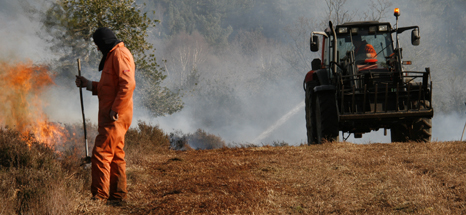 Open Forest Manager Dave Morris explains why you might see controlled heath fires around the New Forest in the coming weeks and the benefits they bring.
Open Forest Manager Dave Morris explains why you might see controlled heath fires around the New Forest in the coming weeks and the benefits they bring.
In the next few days and weeks we are hoping for drier weather to allow us to carry out our annual controlled burning programme across the Crown lands of the New Forest. We usually start the process of burning areas of heather and gorse in February, to encourage new growth that brings benefits to a variety of plants and wildlife.
The cold snap hampered our start this year, but the still-wet ground now offers protection to the peaty soil. Last week we began ‘test burning’ at a few small sites, which determined the readiness of the vegetation for burning and once satisfied, we’ll begin our programme in earnest.The target programme this season is 263 hectares – which is only 2% of the total heathland area across the Crown lands. But even this relatively small proportion of heath offers a valuable mosaic effect of different aged habitats, which as well as providing diversity also provides us with effective firebreaks to protect large areas of heathland, woodland and private property from wildfire.
Other landowners managing publicly accessible Sites of Special Scientific Interest land take a similar approach to burning, which encourages the heather to regenerate. This includes the National Trust and we’ve recently been advising Hampshire and Isle of Wight Wildlife Trust staff about the use of controlled burning as a tool to help manage heaths which they look after.
Our staff have excellent practical knowledge of the Forest and whilst it may look dangerous at first, I can assure you that we have work closely with Hampshire Fire and Rescue Service during our burning season. This enables them to build on practical experience and knowledge of fire behaviour on heathlands and how to tackle them in a wildfire situation.
We have two to three teams of experienced burners, made up of Forestry Commission staff and trained contractors, who work to complete as many burns as possible in the short time available. They are assessing ground conditions on a daily basis to make sure that they remain suitable. At first, we’ll complete just a couple of sites a day but we’ll progress to around ten controlled burns a day across the New Forest. The smoke can hang in the still air during periods of settled weather and it’s not unusual for both the Forestry Commission and Fire Service to receive many calls about the Forest being ‘on fire’!
Open burns across the Forest can look alarming to passers by, but the controlled nature and planned programme of works have real benefits for the Forest environment and the area will quickly recover. Heathland is a low nutrient habitat and needs to be maintained. Otherwise, the vegetation would rot and decay in-situ, returning nutrients to the soil which would affect and ultimately destroy the delicate balance of our heathlands.
The wildlife and vegetation actually benefit from our intervention. For example, woodlarks do well on newly bare ground and reptiles and insects thrive from the ‘edge’ effect that is created. Far from tampering with nature, this work is in fact protecting it and ensuring the local landscapes we know and love are here for many years to come.
Research part-funded by the New Forest Higher Level Stewardship (HLS) Scheme provides scientific evidence that burning does ‘encourage good quality heath, high dwarf shrub cover, low bracken cover, habitat for some heathland specialist invertebrates and, in the early years, open habitat for reptiles and ground active invertebrates.’
For more information about forestry operations in the New Forest please visit www.forestry.gov.uk/newforest